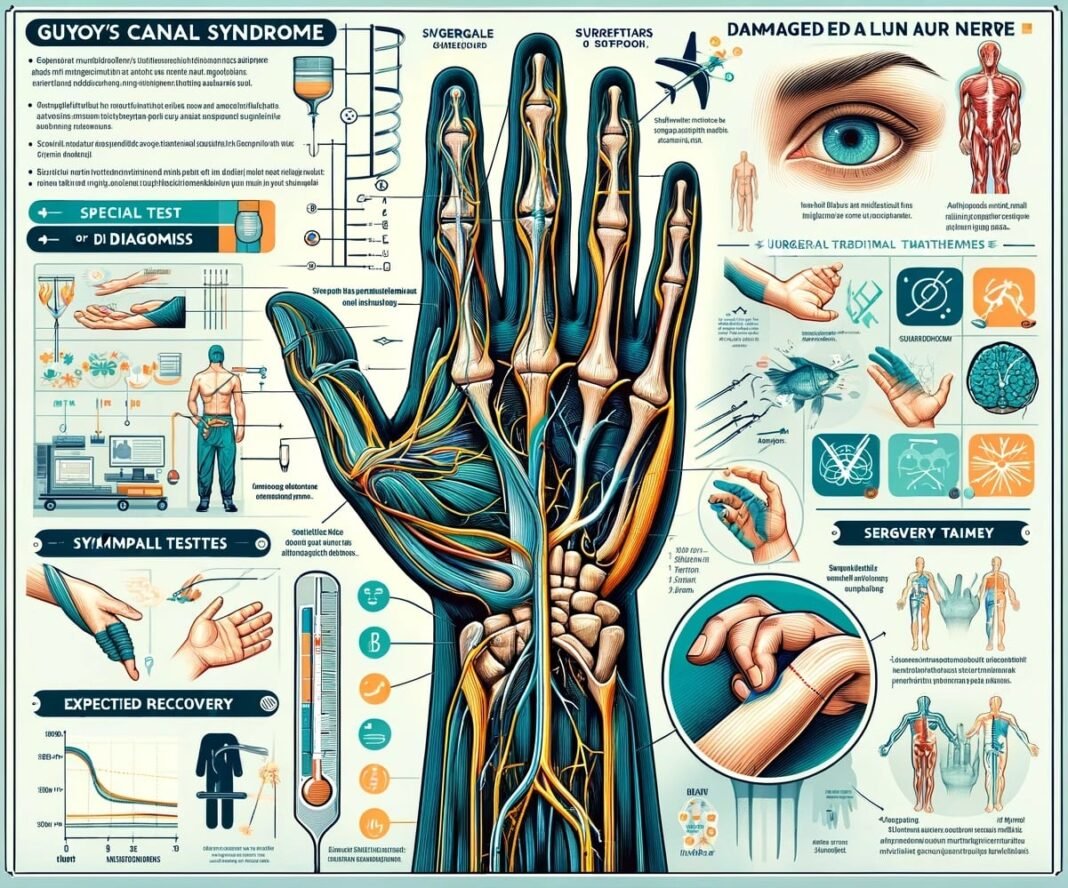Guyon’s Canal Syndrome, also known as ulnar tunnel syndrome, is a condition that affects the ulnar nerve where it passes through a tunnel in the wrist called Guyon’s canal. This syndrome can cause a variety of symptoms, mainly impacting the hand and fingers. The ulnar nerve is responsible for sensation in the ring and little fingers and controls most of the fine movements of the hand. Therefore, compression or irritation of this nerve can lead to significant discomfort and dysfunction.


10 Guyon Canal Syndrome Symptoms
Here, we’ll explore ten symptoms commonly associated with Guyon’s Canal Syndrome, their implications, and the underlying mechanisms.
1. Numbness in the Ring and Little Fingers
One of the hallmark symptoms of Guyon’s Canal Syndrome is numbness or a lack of sensation in the ring and little fingers. This occurs because the ulnar nerve, which provides sensation to these fingers, is compressed.
2. Tingling or “Pins and Needles”
Along with numbness, individuals may experience tingling sensations or a feeling of “pins and needles” in the ring and little fingers. This sensation is often a sign of nerve irritation within Guyon’s canal.
3. Hand Weakness
Compression of the ulnar nerve can lead to weakness in the hand, particularly in the grip strength. This might make it difficult to perform tasks that require fine motor skills, such as buttoning a shirt or holding a pen.
4. Muscle Wasting in the Hand
With prolonged compression of the ulnar nerve, there can be noticeable muscle wasting in the hand, especially in the muscles between the fingers and along the small finger side of the hand. This can lead to a noticeable loss of hand muscle bulk and strength.
5. Difficulty with Finger Coordination
Guyon’s Canal Syndrome can impair the ability to coordinate finger movements, affecting precision tasks like typing or playing musical instruments.
6. Pain in the Wrist or Hand
Some individuals may experience pain in the wrist or hand, which can vary from a mild discomfort to a severe ache. This pain may worsen with hand movement or when pressure is applied to the area.
7. Claw Hand Deformity
In severe cases, Guyon’s Canal Syndrome can lead to a claw hand deformity, where the ring and little fingers may bend towards the palm. This occurs due to imbalances in muscle strength caused by the ulnar nerve compression.
8. Loss of Finger Dexterity
The condition can lead to a loss of dexterity in the fingers, making fine motor skills more challenging and less precise.
9. Sensation Loss in the Hand
Beyond the fingers, some individuals may experience a loss of sensation on the inner aspect of the hand, corresponding to the areas where the ulnar nerve provides sensory feedback.
10. Reduced Reflexes
Although less common, Guyon’s Canal Syndrome can lead to reduced reflexes in the hand, reflecting the impact of nerve compression on the muscular responses.
Understanding and Managing Symptoms
Early recognition and treatment of Guyon’s Canal Syndrome are crucial for preventing permanent damage to the ulnar nerve. Conservative treatments include rest, splinting, anti-inflammatory medications, and physical therapy. In more severe cases, surgery may be necessary to relieve pressure on the nerve.
Conclusion
Guyon’s Canal Syndrome presents a range of symptoms that can significantly impact an individual’s hand function and quality of life. Understanding these symptoms is the first step toward seeking appropriate treatment and managing the condition effectively. If you experience any of these symptoms, consulting with a healthcare provider is essential for a proper diagnosis and to discuss treatment options tailored to your specific needs.
FAQ:
What is the Special Test for Guyon Canal Syndrome?
The special test for diagnosing Guyon Canal Syndrome is the Tinel’s sign at the wrist. This test involves tapping over the Guyon’s canal, where the ulnar nerve passes into the hand. A positive Tinel’s sign is indicated by a tingling sensation or pain radiating into the ring and little fingers, suggesting ulnar nerve compression or irritation.
What Are Symptoms of a Damaged Ulnar Nerve?
Symptoms of a damaged ulnar nerve include:
- Numbness and tingling in the ring and little fingers.
- Weakness in the hand, affecting grip strength and finger coordination.
- Muscle wasting in the hand, particularly noticeable in the small muscles.
- Claw-like deformity of the hand, with the ring and little fingers bending towards the palm.
- Pain or discomfort in the forearm and hand.
What Is the Surgery for the Ulnar Nerve in Guyon’s Canal?
The surgery performed to alleviate ulnar nerve compression in Guyon’s Canal is known as ulnar nerve decompression surgery. This procedure typically involves relieving pressure on the ulnar nerve by cutting the ligament that forms the roof of Guyon’s canal or removing any other structures that are compressing the nerve, to improve symptoms and prevent further nerve damage.
What Is the Recovery Time for Guyon’s Canal Syndrome?
The recovery time following surgery for Guyon’s Canal Syndrome varies but generally includes an initial recovery phase of 3 to 6 weeks. Complete recovery, which encompasses the return of full strength and sensation, may take several months. The specific duration depends on factors such as the severity of nerve compression, how long the symptoms were present before surgery, and the patient’s commitment to following through with rehabilitation exercises and protocols.

